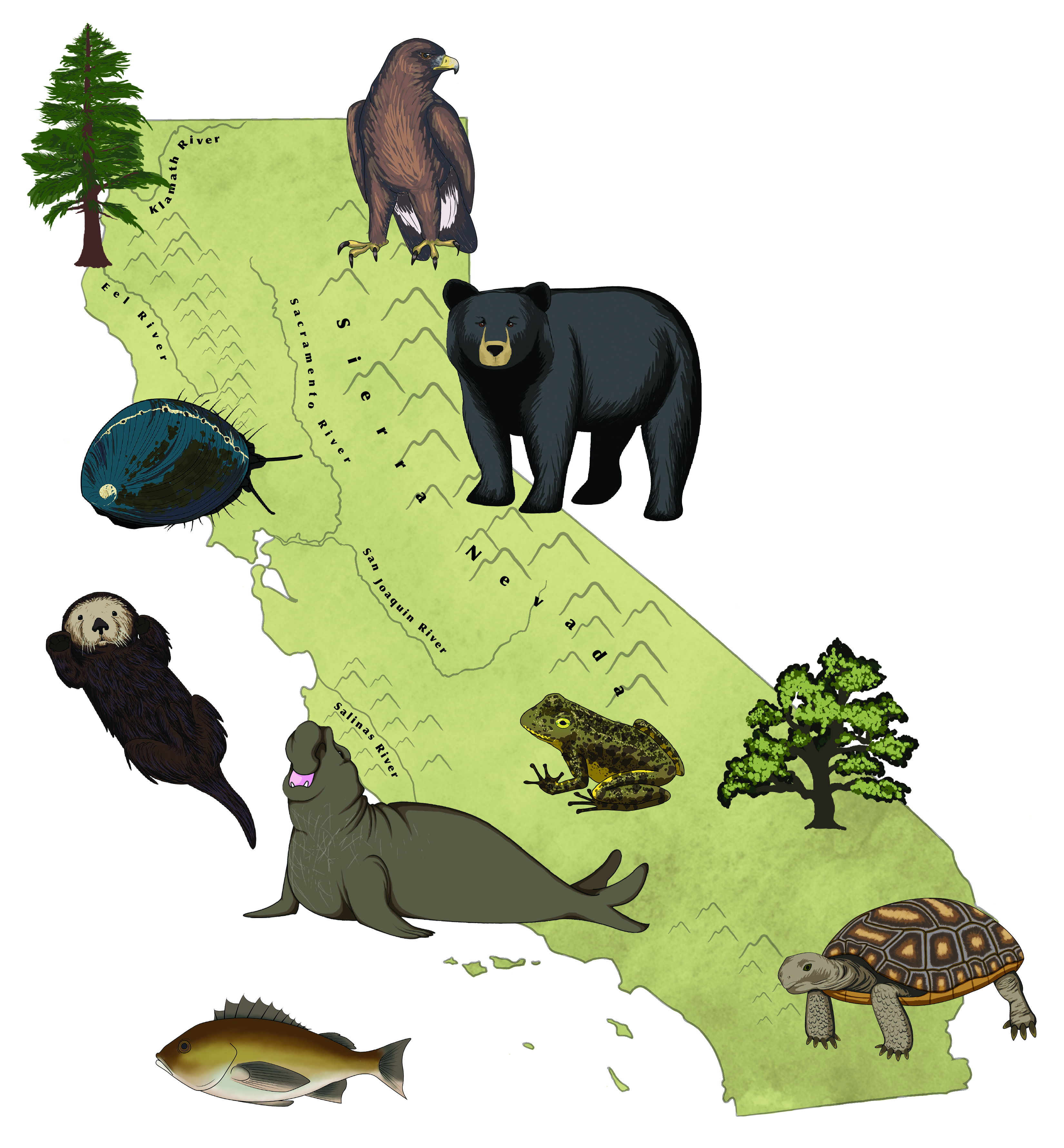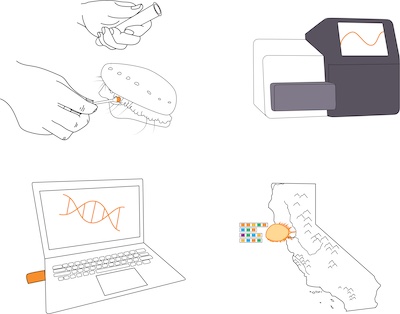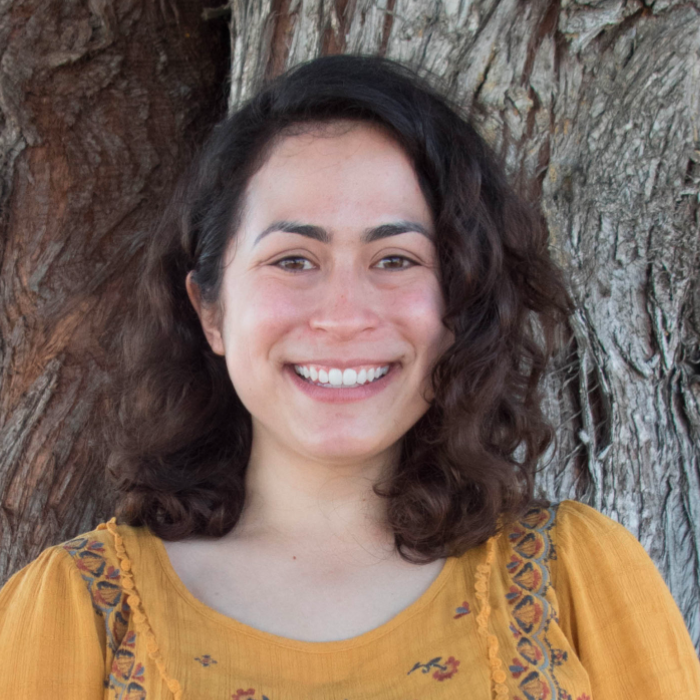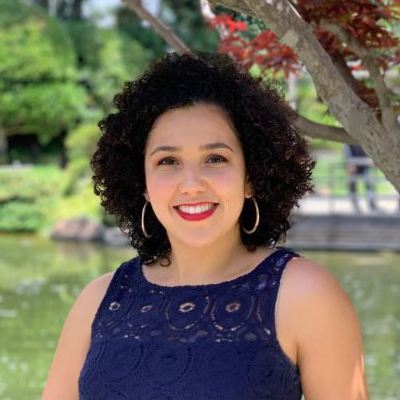The big data of biodiversity
How California will use powerful genomics technology to shape the future of conservation in the state, Jerimiah Oetting reports. Illustrations by Sonja Pinck and Samantha Johnson.

Illustration: Sonja Pinck
Along the central California coast, a crescent of rocky shoreline cradles the waters of the Monterey Bay. Its reefs and tidepools are teeming with sharp and squishy creatures that call the briny coastline home. But during an afternoon low tide on an unseasonably warm February day, a patch of coast just south of the town of Monterey is crawling with dozens of alien visitors: clipboard-wielding scientists in rubber boots, shouting to each other over the din of the wind and waves.
They’re here to count crabs, sample sea stars, measure anemones — to poke around and puzzle over the tidepools. Chloe Orland, a post-doctoral researcher from the University of California, Santa Cruz is among them. But she’s on her own mission. With an arm wedged uncomfortably between two barnacle-encrusted rocks, she’s poking around a bit more literally.
“Oh yes!” she yells triumphantly, freeing her arm and brandishing a long, crooked cotton swab. “It’s so satisfying when you feel your swab really touching that flesh!”
The freshly swabbed flesh belongs to a black abalone — a species of critically endangered sea snails that are few in numbers and difficult to find. They squeeze into cramped rocky corners, their flesh hidden beneath a black shell that is slick and grooved like a vinyl record. With a flick of her swab, Orland can collect enough DNA to piece together each individual’s entire genome.
By collecting swabs from across the black abalone’s range — the Baja peninsula to just north of San Francisco — Orland hopes to discover some of the cryptic gastropod’s secrets. And maybe, learn how to save them from extinction.
It’s not a goal that comes cheaply, or without help. Gleaning useful insights from innumerable pieces of DNA requires the latest in genetic sequencing technology, including expensive equipment. And it demands the expertise of an entire genomics lab: statisticians, data managers and geneticists. For many conservation scientists, the full power of genomics is just beyond reach.
But the state of California is investing in a project that aims to change that — and not just for Orland’s black abalone.
The California Conservation Genomics Project has selected roughly 200 threatened, endangered or otherwise valuable California species, proposed by researchers across the University of California system. The $10 million state-funded project is producing complete genomes of between 100 and 150 individuals for each selected species, hoping to capture the genetic variation that exists across each species’ habitat.
In doing so, California will become the first state to publicly invest in a genomics database, with the objective to inform smarter development and more effective conservation. With the full genomes of around 22,000 individuals, sampled across a representative mélange of California ecosystems, the project aims to illuminate how biodiversity flickers and fades across the state.
“This is a major step in an effort from the state of California to really modernize our natural resource management,” says Mark Gold, the deputy secretary of Ocean and Coastal Policy for the California Natural Resources Agency. “It’s definitely going to be used for decision making — absolutely.”
The Numbers Behind Biodiversity
Beth Shapiro, Orland’s advisor and the co-director of the Paleogenomics lab at UC Santa Cruz, says California’s taxpayers should care about biodiversity, because “the biodiversity of this state supports their existence.”
We rely on other species for everything, Shapiro says, including the food we eat and the houses we live in. She explains this with a weary impatience, like the need for biodiversity on the planet should be as obvious as the need for oxygen.
California is currently home to the most diverse plant and animal life in the U.S. The California Floristic Province, a region of western North America defined by a Mediterranean climate, is centered on California. It includes nearly 7,000 native plants, roughly one third of which are species found nowhere else on the planet.
But the threats to this trove of biodiversity are many: climate change is impacting large swaths of habitat; wildfires devastate whole regions of the state in sudden, catastrophic bursts; and an ever-expanding population is pushing development into formerly wild lands, shrinking and fracturing many species’ habitats.
These threats aren’t exclusive to California — the state is a microcosm of the rapid loss of biodiversity happening all around the world.
“We are in the middle of a mass extinction event,” Shapiro says. “We have just begun to discover the diversity of organisms with which we share this planet. Understanding [their] losses…is critical to understanding the impact of our own species.”
The term ‘biodiversity’ describes the variety of life on the planet or within its many regions, ecosystems and habitats. It connotes resiliency — the more biodiverse an ecosystem is, the more likely it will persist in the face of new threats, like a warming climate or a natural disaster.
An individual’s genome is like the raw data underlying that biodiversity. The genetic variation across individuals of a species reflects their adaptability. The more genetic diversity within a species, the more likely some of its individuals possess the adaptions needed to survive an emerging threat. Conversely, a species that lacks variation is brittle — a single new threat might doom it to extinction.
The threat of extinction erodes biodiversity and can send whole ecosystems spiraling into collapse, and that’s bad for all the species that rely on those ecosystems — including humans. To Brad Shaffer, the director of the CCGP, it’s why the project is so important, and why he hopes other states will follow California’s lead.
“California is the place to do this,” he says. “We have the biodiversity, we have the political wherewithal, we have public interest and support. It’s the right place.”
It’s also the right time to do this, according to Shaffer. Advances in sequencing methods have rapidly outpaced many other technologies, increasing in speed and reducing costs by several orders of magnitude. It’s what could enable the CCGP to accomplish its goals in just three years with $10 million — an amount of time and money that would have been wildly inadequate until very recently.
“Now we’re doing millions of [DNA] fragments, billions of fragments, at the same cost that we used to do smaller genomes in the past,” says Nader Pourmand, a biomolecular engineer at UC Santa Cruz. “The cost of sequencing has really reduced drastically.”
Genetic-ist Isolation
Conservation scientists have long known the power of genomics, but their work is often done independently of one another. Shaffer says by bringing scientists together, and ensuring their data is all standardized to the same high quality, the CCGP’s value will be greater than the sum of its parts.
“It just became clear to me that doing this not in a piecemeal way, but doing this in a comprehensive way, should be a major goal,” he says. “It’s really going to inform us, if we choose our species carefully, about the state as a whole.”
Shaffer studies reptiles and amphibians at UCLA, and has demonstrated how genomics can inform recommendations made by land managers at the state and federal levels.
One of these recommendations concerned the foothill yellow-legged frog, a species once widely distributed from southwestern Oregon to southern California, but now found in less than half of its original habitat. In 2017, the California Department of Fish and Wildlife needed to assess if the frog qualified for protections under the California Endangered Species Act.
“California is the place to do this…we have the biodiversity, we have the political wherewithal, we have public interest and support. It’s the right place.”
To understand the species’ risk of extinction, Shaffer and his team measured genetic diversity by comparing full genomes from individuals across the state. They found a surprising result: the yellow-legged frogs’ breeding groups were so distinct they qualified for different protections.
“[The state] explicitly used that data to identify management units and then list them at different levels,” Shaffer says. “Some of them endangered, some of them threatened, and then half the range not listed at all.”
The CCGP’s data will be even more robust for each of its roughly 200 species, he says. Compiling the full genomes of so many individuals will provide a common yardstick for comparing biodiversity across California.
“The real novelty of it is not just in using landscape genetics or landscape genomics for conservation purposes,” says Shaffer. “The real novelty is in the scope of it.”
Species in Peril
For a group of animals that once dominated California’s coastline, black abalone are now scarce.
“They’re very emblematic of California, culturally and historically,” Orland says. “For an invertebrate, they’re pretty charismatic.”
They’re also critically endangered. In a 1962 report about abalone to the California State Legislature, a CDFW employee named Keith W. Cox wrote of black abalone’s distribution: “[They are] usually found in great numbers crowded close together, and at times stacked two or three on top of each other…they obtain food by grazing on each other’s shells.” Today, black abalone are so rare scientists keep their study sites secret to prevent poaching.
Demand for abalone meat fueled a prosperous commercial fishery for decades, peaking in the 1950’s. But overfishing eventually caused the population to decline — a problem compounded by a new disease discovered in the 1980’s on the Channel Islands, near the coast of Southern California. Fishermen began reporting empty shells and shriveled, weak abalone — symptoms of what is now known to be withering syndrome. The disease is caused by a bacteria that prevents abalone from digesting food.
“They starve, they can’t feed themselves, and so their tissue withers,” Orland says. “It’s very nasty.”
The overlapping threats of overfishing and disease led to the closure of the commercial fishery in 1996.

Each abalone swab contains enough genetic information to piece together a full genome. Illustration by Samantha Johnson
Black abalone’s endangered status and cultural significance make it a solid candidate for the CCGP. Orland says the genomics data will help solve many of their mysteries: how each population differs genetically, and how close to extinction the species really is.
Though black abalone mostly look alike, their similarity obscures the hidden characteristics that lie in their DNA. Some populations are more resistant to withering syndrome, for example. Identifying the genetics behind that resistance could help scientists understand how to save them.
As genomics technology continues to improve, and if its power for conservation can be demonstrated by projects like the CCGP, scientists seeking to protect biodiversity will have another tool to help curb the risk of extinction.
Sequence the World
The CCGP is only one of many genomic repositories that are planned around the world. In the United Kingdom, the Darwin Tree of Life Project aims to sequence all of that country’s species. The Oz Mammals Genomics Initiative hopes to do the same with mammals in Australia. The Genome 10K project is yet another example — an international collaboration co-directed by UC Santa Cruz faculty, which aims to “sequence the genomes of as many animals as possible.”
Because the goals of these projects often overlap, many are connected. The Genome 10K Project facilitates a number of other projects, for instance, including the Vertebrate Genomes Project, which has its sights set on sequencing 66,000 of the world’s vertebrates. It also works with the 1,000 bats project (Bat1K) and ten thousand birds project (B10K). Name a group of species in peril, and there are likely scientists pooling their genetic data to try and save them.
But all of these examples are collaborating with what is, by definition, the largest genomics project of all. The Earth BioGenome Project’s goal is to sequence the DNA of 1.5 million species by 2030.
“It’s a little bit ambitious,” says Stephen Richards, a project scientist with the EBP. Beyond collaborating with other international projects, Richards says the EBP is working with governments around the world to fund similar projects in every country. In the U.S., a bill currently in the Senate could achieve that goal, by funding the creation of a genomic database for all of the country’s plants, animals and fungi.
“Think of it as infrastructure for the future of biology,” says Harris Lewin, the executive chair of the EBP Working Group. “You can completely revise the tree of life. You basically have the complete library of life on Earth.”
With its focus on landscape genomics across the state of California, the CCGP stands apart as the first of its kind, though its need for high-quality genomes indicates a likely partnership with the Earth BioGenome Project.
“The interface between the Earth BioGenome Project and the [CCGP] is around the production of high-quality genomes,” Lewin says.
Conservation’s Future
“[The CCGP is] a huge investment in science for the future,” says John Carlos Garza, a research geneticist at the National Oceanic and Atmospheric Administration. “We can have this incredible repository of data for species that we’re interested in studying.”
But Garza points it’s merely a first step in truly assessing the biodiversity of the state.
“You’ve got thousands of species in California, particularly once you start including the near-shore marine environment,” he says. “[The data] is necessarily going to be really incomplete.”
Shapiro echoes the statement.
“Is 150 species enough to be able to solve the entire extinction crisis? Obviously not,” she says. “But for any of the 150 species that gets selected for this, you get a win.”
One of the stated goals of the CCGP is to inform future development projects in the state. Its data can reveal areas rich with biodiversity, and areas with a concerning lack of it. That information could inform state regulations requiring developers to build in a way that poses the least impact to biodiversity.
But Garza is skeptical the new information will inspire meaningful change for development. Conservationists already make recommendations based on the best available knowledge, and their concerns are often ignored in favor of profitable businesses and the needs of an expanding population, he says. The CCGP’s revelations may increase the precision with which scientists approach conservation. But there’s no guarantee the project’s findings will change how the state uses that information.
State leaders argue the project reflects their commitment to a more environmentally friendly state.
“The purpose of doing this was to catalyze this transformation in how we manage our natural resources and wildlife,” says Gold of the California Natural Resources Agency.
A World of Wounds
Back on the shoreline of the Monterey Peninsula, Orland swabs her last abalone as the rising tide urges the land-faring scientists back to their own habitat.
An empty abalone shell catches a glint of the setting sun from atop the rocky reef. The shell seems to have imbibed everything about its coastal surroundings: the iridescence of shining seas, the turquoise and maroon of neighboring marine life — even the slick appearance of wet stone. Evolution carved it a spot along the California’s coast, and it fits in beautifully. But perhaps not for much longer.
“We’re in the middle of an extinction crisis, and we’re losing species every day,” warns Shapiro.
A lingering scientist totters over to the shell, picking her way across the mussel-covered rocks, and moves it out of sight. She says it’s always a good idea to hide empty shells. Otherwise, they might attract abalone poachers. It’s a risk this iconic species, like so many others across California, can ill-afford.
© 2020 Jerimiah Oetting / UC Santa Cruz Science Communication Program

Jerimiah Oetting
Author
B.S. (ecology, evolution & behavior) University of Minnesota, Twin Cities
Internships: Monterey County Weekly, San Jose Mercury News, Santa Cruz Local, Princeton University
I was a few hundred feet from the summit of Mt. Siyeh, one of the highest peaks in Glacier National Park, when I spotted a grizzly. The massive animal was flipping over stones and catching the resultant flurry of tiny moths with well-timed snaps of its jaw. I wondered why a bear would climb thousands of feet for such a miniscule food source, and I felt inspired to describe the captivating scene to others.
We humans have distanced ourselves from the raw struggle for survival through invention, but are there limits to what technology can solve? Science and storytelling have always been intrinsic to our success as a species. As a science communicator, I hope to use both to untangle our endeavor to make peace with the planet.

Sonja Pinck
Illustrator
B.S. (Evolution, Ecology, & Biodiversity) University of California, Davis, 2015
Internships: Fort Ord Natural Reserve (Marina, CA); Redwood Discovery Museum (Eureka, CA)
Sonja has been staring at animals of all kinds for as long as she can remember. Much of her early childhood was spent in the backyard collecting snails and examining insects as they walked by. When she wasn’t outside, she could often be found drawing her family’s pets or any other creature, real or not.
As she grew, so did her love for art and biology. It seemed only natural to her to pursue these passions. After graduating from the University of California, Davis, Sonja discovered the Science Illustration Certification Program at California State University, Monterey Bay. She immediately knew what her next moves would be, no matter how long it took. After a lot of hard work, feedback, and getting waitlisted once, Sonja was accepted into the class of 2019-2020. Participating in the program was a dream come true for Sonja. It validated her passions and inspired her like nothing else had done before. She knew she was meant to be a science illustrator.
Now that Sonja is finishing up her time in the program, she hopes to continue to use her artwork to bring attention to obscure or lesser-known animals, behaviors, and processes. With a pencil and sketchbook in hand, Sonja is setting out to entertain and educate the world.
In her spare time, Sonja likes to make various crafts, bake, spend time with family and friends, and play Japanese crane games.
Artist website: www.pinkfigstudios.com

Samantha Johnson
Illustrator
B.S. (Marine Biology) California State University at Long Beach
Internships: California State University at Long Beach Shark Lab (Long Beach CA), Beautiful Critters (Los Angeles, CA)
Samantha loves to find interesting things and share them with others. She is a freelance science illustrator and animator, who is also involved in her tribe, the Gabreleno Tongva Band of Mission Indians. Prior to the CSUMB Science Illustration program, she was a husbandry volunteer at the Aquarium of the Pacific, where the endangered frogs she looked after were her favorite art subjects.
Samantha hopes to build a bridge between scientists and the public using fun and easy to understand illustrations and animations that can be used for a wide range of ages to encourage a curiosity for the natural world and an urge to conserve nature as much of it as possible. She also hopes to bring awareness to LA locals by representing her tribe, the original natives of Los Angeles.
When she’s not working, she is shopping around for a new audiobook or podcast to listen to while illustrating, or roller skating along the coast of Long Beach.
www.sandandsagestudio.com
I’m not sure who to notify but I saw numerous snowy ploverson laguna beach Sunday march 9th.
They were hunkered down in the sand closer to the shore than I’d had ever seen them. There were dogs on the beach and no protective fencing.
That is laguna beach in santa cruz county